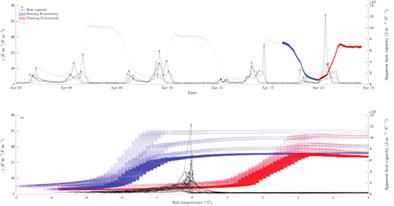当前位置:
X-MOL 学术
›
Hydrol. Process.
›
论文详情
Our official English website, www.x-mol.net, welcomes your feedback! (Note: you will need to create a separate account there.)
Implications of measurement metrics on soil freezing curves: A simulation of freeze–thaw hysteresis
Hydrological Processes ( IF 3.2 ) Pub Date : 2021-06-21 , DOI: 10.1002/hyp.14269 Renato Pardo Lara 1 , Aaron A. Berg 1 , Jon Warland 2 , Gary Parkin 2
Hydrological Processes ( IF 3.2 ) Pub Date : 2021-06-21 , DOI: 10.1002/hyp.14269 Renato Pardo Lara 1 , Aaron A. Berg 1 , Jon Warland 2 , Gary Parkin 2
Affiliation

|
Soil freeze–thaw events have important implications for water resources, flood risk, land productivity, and climate change. A property of these phenomena is the relationship between unfrozen water content and sub-freezing temperature, known as the soil freezing characteristic curve (SFC). It is documented that this relationship exhibits hysteretic behaviour when frozen soil thaws, leading to the definition of the soil thawing characteristic curve (STC). Although explanations have been given for SFC/STC hysteresis, the effect that ‘scale’ – particularly ‘measurement scale’ – may have on these curves has received little attention. The most commonly used measurement scale metric is the ‘support’, which is the spatial (or temporal) unit within which the measured variable is integrated or soil volume sampled. We show (a) measurement support can influence the range and shape of the SFC and (b) hysteresis can be attributed, in part, to the support and location of the measurements comprising the SFC/STC. We simulated lab measured temperature, volumetric water content (VWC), and permittivity from soil samples undergoing freeze–thaw transitions using Hydrus-1D and a modified Dobson permittivity model. To assess the effect of measurement support and location on SFC/STC, we masked the simulated temperature and VWC/permittivity extent to match the instrument's support and location. By creating a detailed simulation of the intra- and inter-support variability associated with the penetration of a freezing front, we demonstrate how measurement support and location can influence the temperature range over which water freezing events are captured. We show it is possible to simulate hysteresis in homogenous media with purely geometric considerations, suggesting that SFC/STC hysteresis may be more of an apparent phenomenon than mechanistically real. Lastly, we develop an understanding of how the location and support of soil temperature and VWC/permittivity measurements influence the temperature range over which water freezing events are captured.
中文翻译:

测量指标对土壤冻结曲线的影响:冻融滞后的模拟
土壤冻融事件对水资源、洪水风险、土地生产力和气候变化具有重要意义。这些现象的一个特性是未冻结水含量与低于冰点温度之间的关系,称为土壤冻结特征曲线 (SFC)。据记载,当冻土解冻时,这种关系表现出滞后行为,导致土壤解冻特征曲线 (STC) 的定义。尽管已经对 SFC/STC 滞后给出了解释,但“尺度”——尤其是“测量尺度”——可能对这些曲线产生的影响很少受到关注。最常用的测量尺度度量是“支持”,它是空间(或时间)单位,在该单位内测量变量被整合或土壤体积采样。我们表明(a)测量支持可以影响 SFC 的范围和形状,(b)滞后可以部分归因于包括 SFC/STC 的测量的支持和位置。我们使用 Hydrus-1D 和改进的 Dobson 介电常数模型模拟了实验室测量的温度、体积含水量 (VWC) 和经历冻融转变的土壤样品的介电常数。为了评估测量支持和位置对 SFC/STC 的影响,我们屏蔽了模拟温度和 VWC/介电常数范围以匹配仪器的支持和位置。通过创建与冻结锋的穿透相关的支撑内和支撑间可变性的详细模拟,我们展示了测量支撑和位置如何影响捕获水冻结事件的温度范围。我们表明可以在纯几何考虑的情况下模拟均质介质中的滞后现象,这表明 SFC/STC 滞后现象可能更像是一种明显的现象,而不是机械上的真实现象。最后,我们了解土壤温度和 VWC/介电常数测量的位置和支持如何影响捕获水冻结事件的温度范围。
更新日期:2021-07-06
中文翻译:

测量指标对土壤冻结曲线的影响:冻融滞后的模拟
土壤冻融事件对水资源、洪水风险、土地生产力和气候变化具有重要意义。这些现象的一个特性是未冻结水含量与低于冰点温度之间的关系,称为土壤冻结特征曲线 (SFC)。据记载,当冻土解冻时,这种关系表现出滞后行为,导致土壤解冻特征曲线 (STC) 的定义。尽管已经对 SFC/STC 滞后给出了解释,但“尺度”——尤其是“测量尺度”——可能对这些曲线产生的影响很少受到关注。最常用的测量尺度度量是“支持”,它是空间(或时间)单位,在该单位内测量变量被整合或土壤体积采样。我们表明(a)测量支持可以影响 SFC 的范围和形状,(b)滞后可以部分归因于包括 SFC/STC 的测量的支持和位置。我们使用 Hydrus-1D 和改进的 Dobson 介电常数模型模拟了实验室测量的温度、体积含水量 (VWC) 和经历冻融转变的土壤样品的介电常数。为了评估测量支持和位置对 SFC/STC 的影响,我们屏蔽了模拟温度和 VWC/介电常数范围以匹配仪器的支持和位置。通过创建与冻结锋的穿透相关的支撑内和支撑间可变性的详细模拟,我们展示了测量支撑和位置如何影响捕获水冻结事件的温度范围。我们表明可以在纯几何考虑的情况下模拟均质介质中的滞后现象,这表明 SFC/STC 滞后现象可能更像是一种明显的现象,而不是机械上的真实现象。最后,我们了解土壤温度和 VWC/介电常数测量的位置和支持如何影响捕获水冻结事件的温度范围。



























 京公网安备 11010802027423号
京公网安备 11010802027423号